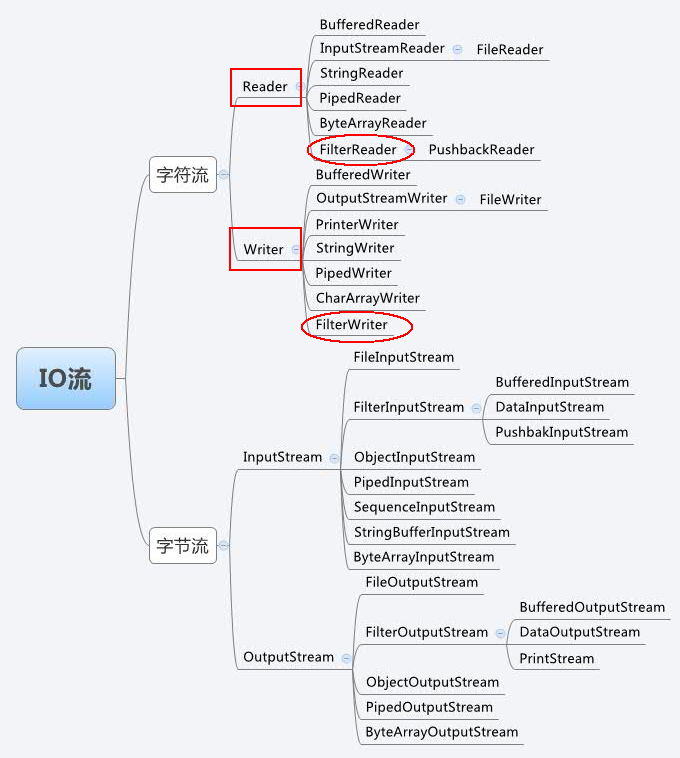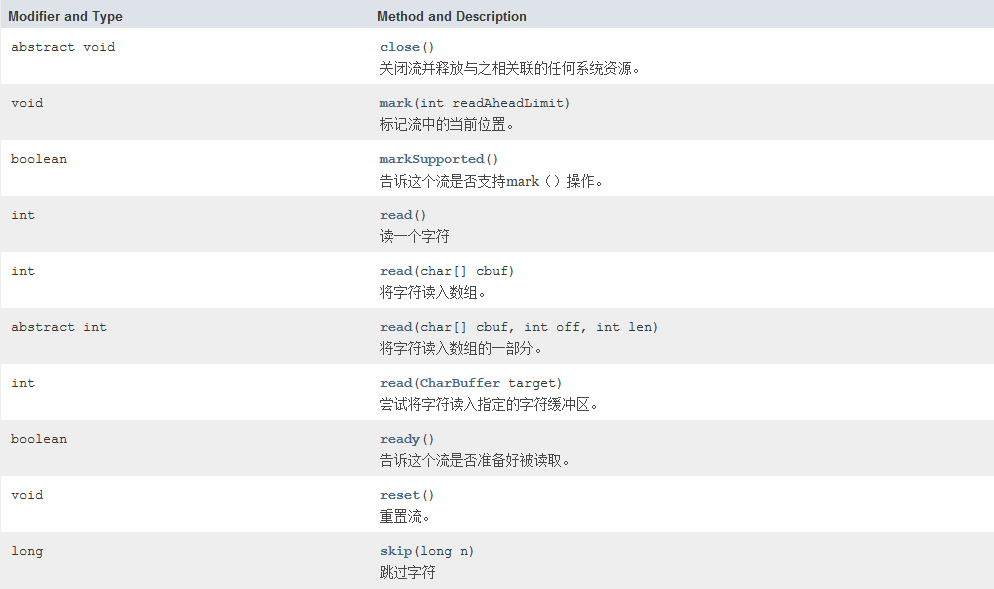那么这篇博客我们讲的是字符输入输出流:Reader、Writer(下图红色长方形框内),红色椭圆框内是其典型实现,图片显示错误(FileReader、FileWriter)

①、为什么要使用字符流?
因为使用字节流操作汉字或特殊符号语言的时候容易乱码,因为汉字不止一个字节,为了解决这个问题,建议使用字符流。
②、什么情况下使用字符流?
一般可以用记事本打开的文件,我们可以看到内容不乱码的。就是文本文件,可以使用字符流。而操作二进制文件(比如图片、音频、视频)必须使用字节流
1、字符输出流:FileWriter
|
1
2
3
|
public abstract class Writer extends Object implements Appendable, Closeable, Flushable |
用于写入字符流的抽象类
方法摘要:

下面我们用 字符输出流 Writer 的典型实现 FileWriter 来介绍这个类的用法:
|
1
2
3
4
5
6
7
8
9
10
11
12
13
14
15
16
17
18
19
20
21
22
23
24
25
26
27
28
|
//1、创建源 File srcFile = new File("io"+File.separator+"a.txt"); //2、创建字符输出流对象 Writer out = new FileWriter(srcFile); //3、具体的 IO 操作 /*** * void write(int c):向外写出一个字符 * void write(char[] buffer):向外写出多个字符 buffer * void write(char[] buffer,int off,int len):把 buffer 数组中从索引 off 开始到 len个长度的数据写出去 * void write(String str):向外写出一个字符串 */ //void write(int c):向外写出一个字符 out.write(65);//将 A 写入 a.txt 文件中 //void write(char[] buffer):向外写出多个字符 buffer out.write("Aa帅锅".toCharArray());//将 Aa帅锅 写入 a.txt 文件中 //void write(char[] buffer,int off,int len) out.write("Aa帅锅".toCharArray(),0,2);//将 Aa 写入a.txt文件中 //void write(String str):向外写出一个字符串 out.write("Aa帅锅");//将 Aa帅锅 写入 a.txt 文件中 //4、关闭流资源 /*** * 注意如果这里有一个 缓冲的概念,如果写入文件的数据没有达到缓冲的数组长度,那么数据是不会写入到文件中的 * 解决办法:手动刷新缓冲区 flush() * 或者直接调用 close() 方法,这个方法会默认刷新缓冲区 */ out.flush(); out.close(); |
2、字符输入流:Reader
|
1
2
3
|
public abstract class Reader extends Object implements Readable, Closeable |
用于读取字符流的抽象类。
方法摘要:

下面我们用 字符输入流 Reader 的典型实现 FileReader 来介绍这个类的用法:
|
1
2
3
4
5
6
7
8
9
10
11
12
13
14
15
16
17
18
19
20
21
22
23
24
25
26
27
28
29
30
|
//1、创建源 File srcFile = new File("io"+File.separator+"a.txt"); //2、创建字符输出流对象 Reader in = new FileReader(srcFile); //3、具体的 IO 操作 /*** * int read():每次读取一个字符,读到最后返回 -1 * int read(char[] buffer):将字符读进字符数组,返回结果为读取的字符数 * int read(char[] buffer,int off,int len):将读取的字符存储进字符数组 buffer,返回结果为读取的字符数,从索引 off 开始,长度为 len * */ //int read():每次读取一个字符,读到最后返回 -1 int len = -1;//定义当前读取字符的数量 while((len = in.read())!=-1){ //打印 a.txt 文件中所有内容 System.out.print((char)len); } //int read(char[] buffer):将字符读进字符数组 char[] buffer = new char[10]; //每次读取 10 个字符 while((len=in.read(buffer))!=-1){ System.out.println(new String(buffer,0,len)); } //int read(char[] buffer,int off,int len) while((len=in.read(buffer,0,10))!=-1){ System.out.println(new String(buffer,0,len)); } //4、关闭流资源 in.close(); |
3、用字符流完成文件的复制
|
1
2
3
4
5
6
7
8
9
10
11
12
13
14
15
16
17
18
19
|
/** * 将 a.txt 文件 复制到 b.txt 中 */ //1、创建源和目标 File srcFile = new File("io"+File.separator+"a.txt"); File descFile = new File("io"+File.separator+"b.txt"); //2、创建字符输入输出流对象 Reader in = new FileReader(srcFile); Writer out = new FileWriter(descFile); //3、读取和写入操作 char[] buffer = new char[10];//创建一个容量为 10 的字符数组,存储已经读取的数据 int len = -1;//表示已经读取了多少个字节,如果是 -1,表示已经读取到文件的末尾 while((len=in.read(buffer))!=-1){ out.write(buffer, 0, len); } //4、关闭流资源 out.close(); in.close(); |